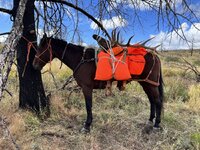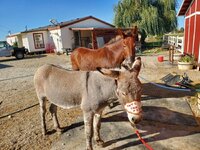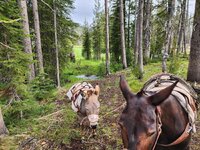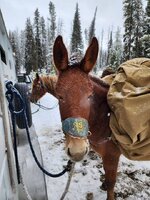TRIP – OCT/24
This was another quick trip. I didn’t want it to be, but the mountain gets a say.
Usual disclaimer: I’m not an expert. I don’t claim to be an expert. I mostly don’t know what I’m doing. Carry on.
The plan was to hit the mountains with some friends, who also have horses. They had some stuff come up last minute and couldn't come, so that sucked. It meant a late start to the day, but that’s okay.
Lesson Learned: Have the mentality that you’re good with JUST riding the horses in the mountains.
If you’re dead-set on a solid hunt (as a newb I mean - real horse dudes can do horses AND get a solid hunt in.) then take a backpack. It’s faster, easier, and yeah. I’m learning that the hunting is secondary – Miles-On-Trail (MOT) has to be the focus, especially with garbage horses. (By that I mean untrained/cheap$$.) If you get MOT, you won the day.
Lesson Learned: You have to be comfortable going out solo.
Self-explanatory. Do whatever it is you have to do so that you can be independent. Too many things come up with hunting partners (Myself included.) Don’t let a change in plans (read: don’t have a buddy with you) stop you from hunting that day. I'm getting way more comfortable being out solo with horses, but for a guy with mostly no background with these critters, managing one horse, let alone two, can feel intimidating.
NEXT
Get loaded up. Same fiasco – Takes forever. Catch horses, hook up trailer, etc. But on the road.
This time I hunt closer to home – Only about an hour and a bit away, and I get to drive with the weekend locals.
NEXT
Get to trailhead. This one has a decent setup for a turnaround, so I’m less on edge about parking.
Again, park, unload horses, unload tack and gear. Brush out horses, tack up. Get personal gear organized and in saddle bags. Get rest of gear in panniers. Stage panniers.
Get myself organized, boots, gaiters, hanwags, (forget spurs again. Fml.)
Rifle on horse. Ready to go. Tighten cinches, start walking horses down trail to get the kinks worked out and gear settled.
Go about 500m and stop. *Visible Confusion* “How the heck do I mount while holding a pony rope in my hand?” Still have no clue. Try a new idea.
Lesson Learned: Same issue of how to properly mount holding a pony horse's lead rope.
I get the mare on the Off side of my gelding, towards his rear quarter. She is happy to stand by his butt-end and not move. I take the lead rope and drape it across the top-ish of my cantle bag.
Note: My gelding is broke to ropes. They don’t bother him. I let go of the rope, and focus on keeping my gelding standing without moving.
I go to mount, and success – nobody moves. I grab the lead rope with my right hand, with reins in my left. Off I go, and everything works. Almost looks like I know what I'm doing.
Or does it? I hate the idea of letting go of a lead rope. I have no control over the mare then, and if she wants to take off, she sure can. She’s kinda herd-bound though, so I gambled that she wouldn’t leave. But there still has to be a better way. This “worked”, but seems sketch.
NEXT
Start riding trail. This is awesome. I’m in the mountains, doing all the cool stuff that I’ve seen in that Rokslide “Pictures of Loaded Pack Animals” thread
https://rokslide.com/forums/threads/pictures-of-loaded-pack-animals.31377/ Definitely feeling pretty cool.
We get to some blowdown. Okay, it’s a single tree across the trail. It’s just about chest-height for the horses.
Hmm, would be nice to have a saw or axe. Oh right, I have one, but I left it in the truck. Because this was just a simple day trip, on a well-maintained trail. (There’s a lesson here later.)
I tie up the horses, and walk the timber beside the trail. Find a decent route that is wide enough to fit a horse+panniers through. Continue on.
NEXT
We go around a corner. Old dried up river bank. Boulders and rocks. Gelding goes “WTF” and starts to back up. Just like Dewey Cox: He don’t want none of that s***.
Same issue as my last trip with the river, only today's issue is a boulder field. I thump on him with my hiking boots (Again, no spurs, because I forgot them). I slap with the glove. It gets some forward movement, but still can't get him to start doing one foot in front of the other.
I dismount. (Commence face-slapping from experienced horse people.) I simultaneously register that having my horse stop/balk/refuse, and me dismount, is probably really, really, bad. Horses aren’t dumb. If they know they can get away with something, they will do it every single time.
Lesson learned: I need to know “What” to do when a horse refuses on a trail, without causing a rodeo.
I know some stuff from teaching the horses to go across tarps and stuff in the round pen. But mounted, in the bush, on a rock field where if I come off I’m having a hard landing, isn’t exactly where I want to be learning things the hard way.
Anyway, dismounted, I start walking. Gelding follows hesitantly, but good to go. Mare doesn’t care, and dozily follows along.
We get to the other side of the boulder field. Usual problem: How do I mount with the pony rope. No idea. Hilarity ensues, only this time the cantle trick fails, rope goes the wrong way, I toss it and get out of the danger zone. Mare does her own thing while I turn the gelding around and reach down to grab the dragging lead rope.
“I wish I knew what I was doing.”
We are off again, hopefully covering the remaining 5km without issue, and looking forward to doing some glassing.
NEXT
We start ascending a bit of a hill. Slow going, because it’s rocky and the horses are picking their trail. The gelding also has to haul my fat-a** uphill. He has the short end of that deal.
We make it to the top, and start to veer right. We are into some heavy timber, so can’t see much.
We make the corner, and then are confronted with this crap.
Hmm, so much for well-maintained trail…
Lesson Learned: Just assume there is no such thing as a maintained trail, and always bring your saw.
This ended my hunt. I’m not going to fight the mountain, trying to find a goat trail through blowdown to bypass this stuff. Not with newb horses, and a guy who can’t even manage a pony rope.
I just repeat my mantra: Miles-On-Trail. The ponies got out into the mountains, we did Cool Sh**, and no rodeos so far.
I snap some pictures of the horses doing the Cool Sh**, and we head back.
Gelding doing cool Sh**
Mare doing cool sh**
NEXT
Gelding knows we are heading home. He starts stepping out like crazy. Normally this makes me happy, but my mare can’t go that fast (Or won’t.) So my right arm is taking a beating holding on to this rope with a mare dragging butt at the end of it.
I take a wrap (not really a full wrap, just kind of a U-shape) around the saddle horn. This helps, but I look back and my mare has her head in the air, the bottom of the rope jammed against her bottom lip.
I don’t know if this is normal or not, but I try to get the gelding to slow a bit. It helps, but I keep having to bump the bit. “Easy, Easy”. He slows, then 5 steps later starts giving ‘er again.
No idea what to do about this. Will have to read some stuff, and find out if this is a big deal or not.
NEXT
We get to the dreaded boulder field again. Gelding pauses, but I give him some leg pressure. He steps out with confidence, but can’t go too fast because he has to pick his steps through the boulder field.
I give him his head, lots of rein, and just try to stay balanced for him.
He makes it through no problem. Mare does fine as well, but then proceeds to have her face ripped off again as the gelding starts to cruise home.
NEXT
We make it back to the truck and trailer safely. Ponies get a bit of oats and their water buckets.
Tack comes off, gear packed away. We go to load, and same issue as the other day: Mare loads no problem, gelding doesn’t.
He’s better today, and I get him on with less coaxing and stupidity and pulling, but I still don’t like him refusing. He outweighs me by 900lbs. I’m not going to win a physical battle with this guy. And the old cavalry manuals and stuff don’t talk about trailer loading, because they didn’t exist back then. Definitely need to get something figured here.
WHAT WORKED / WHAT DIDN’T
What Worked:
- The packsaddle rigging. No idea if this way of rigging has a formal name or not. I’ve seen a lot of Northern Canada outfitters run rigs this way, and that same Pat Puckett guy rigs his packsaddle this way. (I’ll do a better post on this later.)
- Long lead ropes. Again, easy way to trail 1-2-3 when going through narrow spots.
- Tapaderos. I get nervous riding in big hiking boots. The taps definitely stop my boots from getting deep in the stirrups. (They do look ridiculous though - Mexican taps in the Canadian bush... But that’s how it goes buying used gear. You take what you can get.)
What Didn’t Work
- Ponying. I’m garbage with the rope handling. Gotta get this sorted
- Too Much To Remember. There’s so many little things to do/prep/remember. I think making a checklist or two so you can just go through the to-do’s on autopilot would be smart.
- Stubborn Horse. Gotta figure out how to deal with a stubborn horse that doesn’t involve dismounting. Don’t want the horse to get smart to this.

















